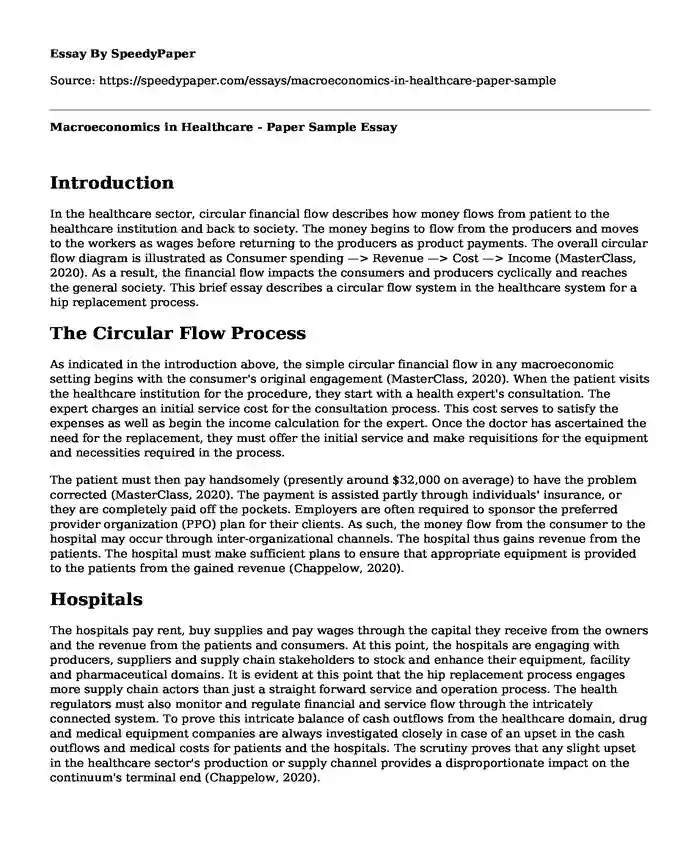
| Type of paper: | Essay |
| Categories: | Macroeconomics Healthcare |
| Pages: | 3 |
| Wordcount: | 608 words |
Introduction
In the healthcare sector, circular financial flow describes how money flows from patient to the healthcare institution and back to society. The money begins to flow from the producers and moves to the workers as wages before returning to the producers as product payments. The overall circular flow diagram is illustrated as Consumer spending —> Revenue —> Cost —> Income (MasterClass, 2020). As a result, the financial flow impacts the consumers and producers cyclically and reaches the general society. This brief essay describes a circular flow system in the healthcare system for a hip replacement process.
The Circular Flow Process
As indicated in the introduction above, the simple circular financial flow in any macroeconomic setting begins with the consumer's original engagement (MasterClass, 2020). When the patient visits the healthcare institution for the procedure, they start with a health expert's consultation. The expert charges an initial service cost for the consultation process. This cost serves to satisfy the expenses as well as begin the income calculation for the expert. Once the doctor has ascertained the need for the replacement, they must offer the initial service and make requisitions for the equipment and necessities required in the process.
The patient must then pay handsomely (presently around $32,000 on average) to have the problem corrected (MasterClass, 2020). The payment is assisted partly through individuals' insurance, or they are completely paid off the pockets. Employers are often required to sponsor the preferred provider organization (PPO) plan for their clients. As such, the money flow from the consumer to the hospital may occur through inter-organizational channels. The hospital thus gains revenue from the patients. The hospital must make sufficient plans to ensure that appropriate equipment is provided to the patients from the gained revenue (Chappelow, 2020).
Hospitals
The hospitals pay rent, buy supplies and pay wages through the capital they receive from the owners and the revenue from the patients and consumers. At this point, the hospitals are engaging with producers, suppliers and supply chain stakeholders to stock and enhance their equipment, facility and pharmaceutical domains. It is evident at this point that the hip replacement process engages more supply chain actors than just a straight forward service and operation process. The health regulators must also monitor and regulate financial and service flow through the intricately connected system. To prove this intricate balance of cash outflows from the healthcare domain, drug and medical equipment companies are always investigated closely in case of an upset in the cash outflows and medical costs for patients and the hospitals. The scrutiny proves that any slight upset in the healthcare sector's production or supply channel provides a disproportionate impact on the continuum's terminal end (Chappelow, 2020).
In the process of costing during hip surgery, the patients are also required to incur some service costs that are not within the hospital's realms. Such costs include post-surgery self-assistance equipment. These extra requirements present an additional layer of production and transaction dynamics within the sector. The patients must be enlightened on their role in acquiring the external support services and equipment to minimize the circular flow system's consumer input side's deficiencies (MasterClass, 2020).
Conclusion
The circular flow system in healthcare is a complex system involving multidisciplinary players in the production, supply and service delivery processes. The present study has succeeded in briefly uncovering some circular flow processes and directions that may require close consideration and integration into the institutions' balance sheet.
References
Chappelow, J. (2020, August 28). How the Circular Flow Of Income Model Works. Investopedia. https://www.investopedia.com/terms/circular-flow-of-income.asp.
MasterClass. (2020, October 2). Understanding the Circular Flow Model in Economics: Definition and Factors of Production. MasterClass.
https://www.masterclass.com/articles/understanding-the-circular-flow-model-in-economics.
Cite this page
Macroeconomics in Healthcare - Paper Sample. (2024, Jan 01). Retrieved from https://speedypaper.net/essays/macroeconomics-in-healthcare-paper-sample
Request Removal
If you are the original author of this essay and no longer wish to have it published on the SpeedyPaper website, please click below to request its removal:
- Free Essay Example on the Global Obesity Scourge
- Free Essay on Health Issues Among Critical Care Nurses
- Paper Example on History of Tobacco Use
- Paper Example on Technology Strategy Recommendation
- Free Essay - What Can We Do to Improve Healthcare?
- Essay on Abortion: A Complex Debate on Life & Death Matters
- How Wearing a Mask in the Classroom can Impact Child's Social Development - Essay Sample
Popular categories




